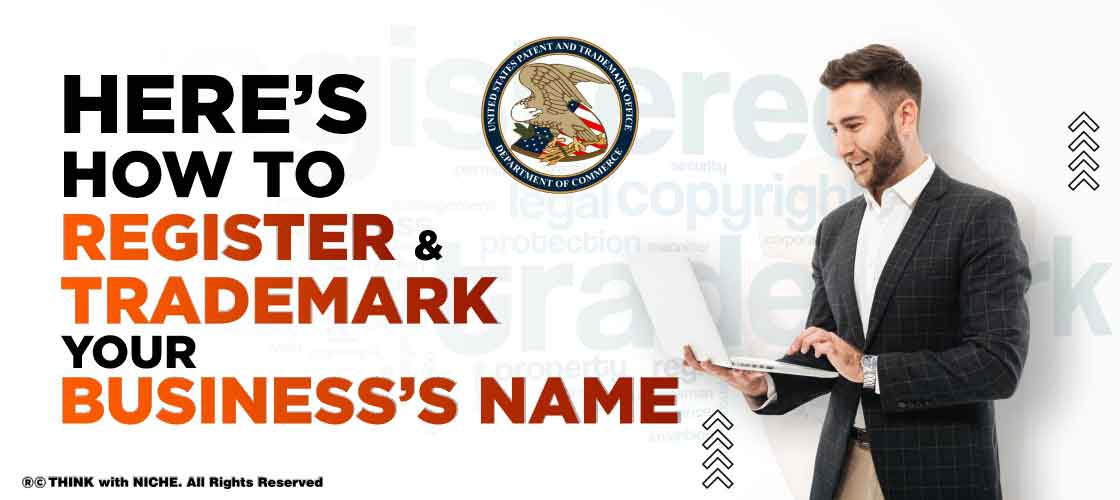Here’s How to Trademark Your Business' Name! ThinkWithNiche

Blog Post
Names have power in business!
Establishing ownership and rights to a business name is an important step for companies that want to keep their name unique. As a business grows, registering a trademark protects a name or brand from intellectual property theft or misuse.
You can begin the trademarking process by visiting the website of the United States Patent and Trademark Office. The application can be completed quickly, but the entire process can take several months. I will just take 10 minutes of your precious time to walk you through the process; so you have a better understanding of the concept before you get on with the process of trademarking your business! #TWN
Registering and trademarking your brand name is the first step in protecting your company's intellectual property. Here's a step-by-step guide to registering a trademark with the United States Patent and Trademark Office.
- It is a simple three-step process to register your brand name as a trademark.
- To protect your intellectual property from infringement, you can register your brand name with the USPTO.
- Obtaining a trademark is not immediately necessary, but it may benefit your brand.
- This article is intended for small business owners who are either ready to register and trademark their brand name or are debating whether they should.
Registering a trademark for your company is an important step that will help you protect your brand identity from misappropriation or theft. The process of registering a trademark is straightforward and can be completed in a few simple steps.
My article will walk you through each step required to register and trademark your brand name, as well as answer some frequently asked questions about trademark registration.
Before we get started, I’ll give you a quick brief overview of what a trademark is! (If you already don’t know)
What is a Trademark?
The United States Patent and Trademark Office (USPTO) defines a trademark as "a word, phrase, symbol, and/or design that identifies and distinguishes the source of one party's goods from those of the others."
Steps to Trademark your Business’ Name
It's not as simple as forming an LLC to trademark your company's name, and it may take longer than you think.
Search
First, make sure the name you want to trademark isn't already protected as a trademark in the federal database. The Trademark Electronic Search System (TESS) of the United States Patent and Trademark Office (USPTO) can help you with this. You should look not only for the name you want but also for names that are similar to it. If your name is too similar to one already registered in the same class, your registration may be denied.
While this appears to be a simple task, it is not. For example, Iguana Ice Cream and Iguana's Ice Cream may be too similar. It could also mean that a registered trademark resembles your mark in appearance or sound or that the meanings are similar.
Apply
It's time to prepare your trademark application after you've searched and cleared the name you want to trademark. You can file for a name that is already in use commercially or one that you intend to use in the future.
The trademark application itself has 10 components:
- The applicant's name and address
- The applicant's citizenship and legal entity
- For future correspondence, a name and address are required (this does not have to be the same as the name of the applicant)
- A drawing of the desired mark (you can just type in the name if you're only applying for the name and don't want to include a design element).
- A detailed description of the trademark
- A list of services or goods that the trademark application covers.
- The type of service or product
- An example of the mark in use, along with the year it was first used
- A dated signature from you or a representative authorized by you
- The appropriate fee for the type and number of classes included on the application
File
You have two filing options after completing the application: TEAS Plus and TEAS Standard. The Plus option is less expensive and more streamlined, as well as having a lower rejection rate. If you need a custom description of your services or goods that isn't available in the preset list, Plus provides the risk associated with the Standard option may be more beneficial for your situation.
You'll receive a confirmation receipt and a serial number from the USPTO once you've submitted your application, which you can use to check the status of your application in the Trademark Status & Document Retrieval (TSDR) portal.
“Key Takeaway: Look for similar names in the TESS database to register and trademark your brand name, then fill out the trademark application and send it to the USPTO for approval."
Copyright vs. Trademark vs. Patent
| Basis | Trademark | Patent | Copyright |
| Definition | A trademark is a phrase, word, or design—or all three—that describes what your business does or sells. Having a trademark can help you distinguish yourself from your competitors. | A patent gives the creator(s) of a new, unique, and useful invention, discovery, or process property rights. Patents are classified into three types: utility, design, and plant. | A copyright is a type of intellectual property that safeguards original works of authorship that are preserved in a tangible medium. |
| Example |
McDonald's Name: I'm Lovin' It Slogan: I'm Lovin' It Logo: The Golden Arches |
The iPhone's design, Bluetooth data transfer technology, and Keurig's K-Cup pod. | You can copyright logos, illustrations, blog posts, websites, articles, advertising copy, and photographs, but not names, individual words, or simple phrases. |
| Length of Protection | Can last indefinitely, but starting five years after registration, you must file periodic maintenance and renewal paperwork. | Typically 20 years! | In general: 70 years plus the author's/life creator's For works created for hire (works created for a company under a contract that grants the company copyright): It's been 95 years since it was published, or 120 years since it was created, whichever comes first. |
| Application Cost | An initial fee of $250 per class of goods/services. | Depending on the size of the company, an initial fee of at least $80, plus fees for search and examination. | Minimum fee of $45. |
Trademark FAQs
What is the difference between a trade name, trademark, and service mark?
A trademark protects products, while a service mark protects services. Both types of marks are sometimes referred to as "trademarks." Both are intended to limit competitors' ability to deceive consumers by making false claims about where a product or service originates.
In place of the official business name, a trade name is used. The phrase "doing business as" is frequently used on paperwork to indicate this (DBA). It's used when the company name is too long or the desired name is too similar to one that already has a trademark or service mark. (It's worth noting that a trade name does not imply the legal entity responsible for the service or product.)
Should you trademark your company name?
It is not necessary to register your trademark to obtain legally protected rights. Simply by using a mark in your business in the United States, you are granted "common-law rights" to it. It means you could start using it right away and prove your ownership by proving you were the first to use it commercially. A common-law trademark, on the other hand, imposes restrictions on your rights.
There are several benefits to filing a federal trademark application. Most importantly, it grants you legal ownership of the mark as well as exclusive rights to use it anywhere in the country in connection with the goods or services you specified during registration. Common-law rights are limited to the immediate geographic area in which you operate, and registering the name with your state protects your rights only within that state's borders.
A public notice stating your ownership will be issued when you register your mark with the USPTO, and it will be listed in the online database. You can also register your trademark with US Customs and Border Protection to prevent foreign goods bearing the same name from being imported if you have a federally registered trademark. In addition, you will be able to use the federal symbol ® instead of the less enforceable ™ mark.
The primary way you present your company to the rest of the world is through its name. Consider the possibility of someone else using your company's name to make offers that contradict your company's mission and values. If you want to give your company the most legal protection possible, you must have a trademark.
When you apply for a trademark, you can only apply for one type of classification. Each additional classification must be specified in the application and is subject to a fee. There are 45 classes to think about. For example, if your company manufactures automobiles, you'll need a Class 12 trademark. If you also wanted to sell clothing with the same company's name on it, you'd need a Class 25 trademark. Consider how you'll use the name when deciding which class or classes to put it in.
Who should trademark their business name?
If your company has a distinctive name, it can be trademarked as long as it is not too similar to another trademarked name. For example, if the name is too broad, such as The Ice Cream Shop, trademark protection is unlikely. Iguana Ice Cream is more likely to be granted a trademark because it combines common words unusually.
It's also crucial to think about the geographic area you'll be serving. The name's common-law trademark protection is limited to your immediate geographic area. If your business operates in multiple states, you should file a trademark application to protect your brand.
If your company has several product lines with distinct names, you should consider trademarking those as well. Ford, for example, is a registered trademark of Ford Motor Company, which also owns registered trademarks for vehicle lines such as the F-150, Mustang, Ranger, and Explorer.
“Did you know? The common-law trademark protection that comes with your business name is only valid in your immediate geographic area. If your company operates in multiple states, you should file a trademark application.”
Should I get a trademark or LLC first?
It is largely dependent on your business goals whether you should register for a trademark or an LLC first.
A limited liability company (LLC) is a type of private limited company that is classified as a business structure in the United States. Although you can get an LLC from any state, it is usually issued by the state where the business is located. An LLC registration usually takes less than a day to complete, whereas trademark registration takes three months on average.
If you want to start operating right away, it's best to register for the LLC first. If you have plenty of time and are more concerned with securing your federal rights to the name before releasing it into the public domain, out of fear of it being co-opted by someone else, it makes more sense to apply for the trademark first.
Does your business need a trademark registration right away?
Your company is not required to register for a trademark right away.
When registering a mark, you must typically be able to demonstrate "use in commerce," which means you must be able to demonstrate that it was being used before you can register it. There is, however, the option of applying for an intent-to-use (ITU) trademark.
If you file an ITU trademark, you must still demonstrate your use of the mark in commerce by completing the documentation and paying the additional fees within the timeframe specified before the mark is registered.
There are only three time periods in which you can claim commercial use:
- Before publication approval
- Within six months of receiving the notice of allowance (NOA)
- Within the time frame specified by an extension
You can establish commercial use in a variety of ways, including the following:
- Placing the mark on your sold goods or your website for sold goods
- Using the mark in connection with the sale of services
Under federal law, there are three types of commerce:
- Foreign trade
- Territorial
- Interstate
Intrastate commerce or business that is limited to the borders of a single state is typically not acceptable.
If your company cannot yet demonstrate that it is using the trademark in commerce, or if you will be unable to do so within the constraints of the ICU process, there is no reason to apply for the trademark first.
If I register a business name, do I need to register a trademark?
Typically, registering a business name is done at the state level, and it does not provide federal protection. There is no reason to register a trademark if you are only going to provide services or products within that state. However, if you offer products and services in multiple states and want federal protection for your company's name, you must register for a trademark.
How can you tell if someone else already has rights to a mark?
TESS makes it simple to search the federal trademark database in a variety of ways. You can use the "basic word mark search" to look up names, words, and phrases that have been granted a federal trademark.
The "word and/or design mark search" option allows you to search the database using either a design or words or a combination of the two. To do this effectively, you will most likely need to know the design codes.
You can also browse the directory or individual fields within the database. If you don't know what was trademarked but know a general date, you can search by registration or publication date.
If your registration is accepted, how long is that registration valid?
Trademark registration is valid for as long as you want to keep it. Once issued, a trademark does not expire as long as it is used for the registered purpose. A trademark, you see, does not grant you ownership of a word, phrase, or image. Instead, it grants you the right to use that word, phrase, or image to identify the services or goods listed in the registration.
However, just using it isn't enough. By filing a Section 8 declaration between the fifth and sixth anniversaries of the registration, you must provide the USPTO with proof that the trademark has remained in use. It is a straightforward sworn statement.
The actual proof is required on the tenth anniversary of the registration. It could be a picture of your product or service that incorporates the trademark. It must be done every ten years.
Also Read: Where to Find Money for your Small Business? Get Small Business Grants!
Do trademarks expire?
Trademarks, unlike patents and copyrights, do not expire after a set period of time. Trademarks will last as long as the owner continues to use them. Once a registered trademark is granted by the United States Patent and Trademark Office (USPTO), the owner must continue to use the trademark in ordinary commerce.
You May Like
EDITOR’S CHOICE












